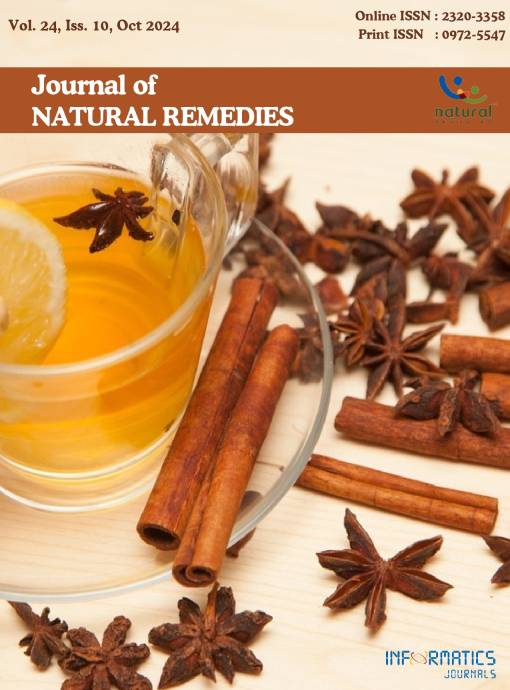Method Development and Validation of Simultaneous Estimation of Lupeol, Diosgenin, Oleanolic Acid and Caffeic Acid in Ayurvedic Formulation by High-Performance Thin Layer Chromatography
DOI:
https://doi.org/10.18311/jnr/2024/44001Keywords:
Caffeic Acid, Diosgenin, DoE, HPTLC, Lupeol, Oleanolic AcidAbstract
Background: Herbal remedies are widely used for wellness due to their reliability, perceived safety and cultural acceptance. Presently, HPTLC is used widely in quantifying phytoconstituents due to its affordability, efficiency, reduced mobile phase consumption and minimal sample clean-up. Aim: The goal of the current research was to develop and validate a fast, accurate HPTLC technique capable of concurrently estimating lupeol, diosgenin, oleanolic acid and caffeic acid in an Ayurvedic formulation. Method: The HPTLC method employed a silica gel G 60F254 coated plate and a mobile phase of n-Hexane: Ethyl acetate: Methanol: Formic acid in 7.2:2:1:0.1, v/v/v/v. Diosgenin, lupeol and oleanolic acid, were derivatised with vanillin-sulphuric acid to enable detection at 449nm, 604nm and 540nm, respectively while caffeic acid was detected at 322nm. The method was validated through ICH Q2 (R2) standards, covering system suitability, linearity, accuracy, precision and robustness. Robustness was evaluated using a Fractional Factorial Design (FFD) of 24-1, investigating both high-level (+2) and low-level (-2) factors. Results: Linearity for lupeol, diosgenin, oleanolic acid and caffeic acid linearity ranged from 1000-5000 ng/band, with correlation coefficients (r2) of 0.9964, 0.9945, 0.9989 and 0.9997, respectively. Limits of both detection and quantification were determined for lupeol (95.26 and 288.68 ng/band), diosgenin (95.27 and 288.67 ng/band), Oleanolic Acid (OA) (91.66 and 277.77 ng/band), and Caffeic Acid (CA) (82.50 and 250 ng/band). Accuracy was evaluated using recovery methods, demonstrating satisfactory outcomes for lupeol 99.54−101.50 %, diosgenin 100.06−101.09 %, OA 99.89−101.09 % and CA 100.40−100.58 %. Precision study % RSD values were < 2%. The Rf values for lupeol, diosgenin, OA and CA were found to be 0.702, 0.525, 0.453 and 0.186, respectively. An FFD tested the HPTLC method’s robustness, showing no impact on lupeol and diosgenin retention factor, but n-Hexane volume significantly influenced OA and CA which is managed carefully. Conclusion: The proposed HPTLC techniques were discovered to be precise, accurate and reproducible. The statistical study demonstrates their consistent repeatability, making them equally appropriate for regular assessment of marketed formulations without prior separation.
Downloads
Metrics
Downloads
Published
How to Cite
Issue
Section
License
Copyright (c) 2024 Janvi Patel, Disha Prajapati, Tanvi Dodiya (Author)

This work is licensed under a Creative Commons Attribution 4.0 International License.
Accepted 2024-08-23
Published 2024-11-06
References
Anonymous, The wealth of India, a dictionary of Indian raw materials and industrial products, publications and information directorate. Council for Scientific and Industrial Research. 1988. p. 114-18.
Rastogi S. Building bridges between Ayurveda and modern science. Int J Ayurveda Res. 2010; 1(1):41-6. https://doi.org/10.4103/0974-7788.59943 PMid:20532097 PMCid: PMC2876924.
Abraham G. A review on hepato-protective herbs used in Ayurveda. Global J Res Med Plants and Indigen Med. 2014; 3(7):303-11.
Sharma S, Goyal S, Chauhan K. A review on analytical method development and validation. Int J Appl Pharm. 2018; 10(6):8-15. https://doi.org/10.22159/ijap.2018v10i6.28279
Andola HC, High-performance thin layer chromatography (HPTLC): A modern analytical tool for biological analysis. Nat Sci. 2010; (8)10:58-61.
Shukla R, Singh PK, Upadhyay S, A comprehensive review of high-performance thin layer chromatography (HPTLC). Int Pharm Res. 2023; 27(1):398-410.
Saibaba SV, Shanmuga P. High-performance thin layer chromatography: A mini-review. Research in Pharmacy and Health Science. 2016;2(4):219-26.
Quality standards of Indian mediational plant (2011, 2017, 2018). Medicinal Plants Division Indian Council of Medical Research New Delhi. 2011, 2017, 2018; 9, 15 and 16.
https://www.planetayurveda.com/library/panaviraladibhasmam [accessed dated: 18/7/2023]
https://en.m.wikipedia.org/wiki/Diosgenin [accessed dated: 18/7/2023]
https://en.m.wikipedia.org/wiki/Lupeol [accessed dated: 18/7/2023]
https://en.m.wikipedia.org/wiki/Oleanolic_acid [accessed dated: 18/7/2023]
https://en.m.wikipedia.org/wiki/Caffeic_acid [accessed dated: 18/7/2023].
Khanam N, Alam MI, Ali Y, Siddiqui AU. A review on optimization of drug delivery system with experimental designs. Int J Appl Pharm. 2018; 10(2):7-12. https://doi.org/10.22159/ijap.2018v10i2.24482
Gujral G, Kapoor D, Jaimini M. An updated review on design of experiment (DOE) in pharmaceuticals. JDDT. 2018; 8(3):147-52. https://doi.org/10.22270/jddt.v8i3.1713
Jain A, Parashar AK, Nema RK, Narsinghani T. Highperformance thin layer chromatography (HPTLC): A modern analytical tool for chemical analysis. Curr Res Pharm Sci. 2014; 04(01):8-14.

 Janvi Patel
Janvi Patel









 0.35
0.35 24
24 0.161
0.161